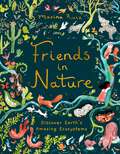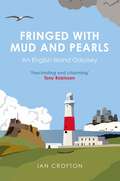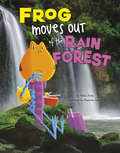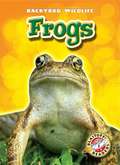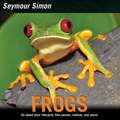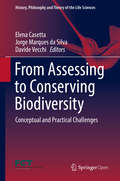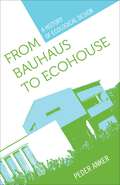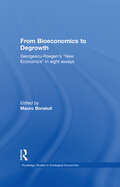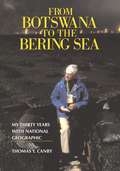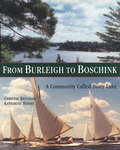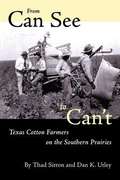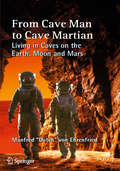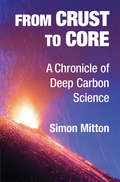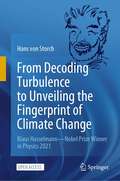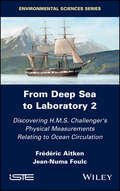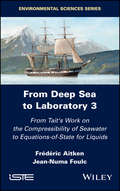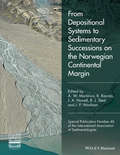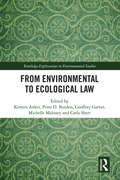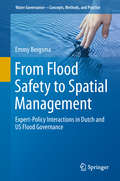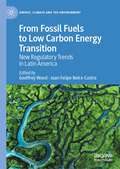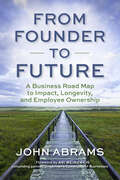- Table View
- List View
Friends Not Food: The Little Book of Vegan Wisdom
by AnonymousChickens, Cows, Ducks, Sheep, Pigs, Rabbits, Trout, Salmon, Prawns, Lobsters - all of the animal kingdom - are not here for us to eat, we should be looking after them.Friends Not Food is a celebration of our relationship with our animal friends and is packed with vegan sayings as well as facts about both those animals and the industries that prey on them.The perfect gift for anyone who loves animals!And whilst you #StayHome, don't miss these other great titles from Sphere Books: ** Distract Yourself: 101 Positive Things to Do and Learn Whilst You Stay Home ** ** The Bumper Book of Would You Rather? Over 350 hilarious hypothetical questions for ages 6 to 106 **** Home Sweet Home: The Little Book of Natural Cleaning **** Shelf Respect: A Book Lovers' Guide to Curating Book Shelves at Home **
Friends Not Food: The Little Book of Vegan Wisdom
by AnonymousChickens, Cows, Ducks, Sheep, Pigs, Rabbits, Trout, Salmon, Prawns, Lobsters - all of the animal kingdom - are not here for us to eat, we should be looking after them.Friends Not Food is a celebration of our relationship with our animal friends and is packed with vegan sayings as well as facts about both those animals and the industries that prey on them.The perfect gift for anyone who loves animals!And whilst you #StayHome, don't miss these other great titles from Sphere Books: ** Distract Yourself: 101 Positive Things to Do and Learn Whilst You Stay Home **** The Bumper Book of Would You Rather? Over 350 hilarious hypothetical questions for ages 6 to 106 **** Home Sweet Home: The Little Book of Natural Cleaning **** Shelf Respect: A Book Lovers' Guide to Curating Book Shelves at Home **
Friends in Nature: Discover Earth's Amazing Ecosystems
by Marina RuizDiscover the incredible ways in which animals and plants help each other, the planet and YOU to thrive with this illustrated tale of symbiosis and ecology for children aged 5-7.Can you imagine a world where you had to do everything by yourself? It's pretty impossible. The truth is, everyone needs a little help from someone, or something.All living things in the natural world - from the trees and the bees to the dogs and the frogs - depend on one another. There wouldn't be a coral reef without the help of all the fish that have made it their home. Rainforests are only filled with lush and colourful plants because of the birds and mammals who eat and scatter their seeds. Acacia trees have a whole army of ants to protect them, while elephants rely on egrets to keep them parasite-free. And it's because of bees, wasps and butterflies that we have tasty fruit and vegetables to eat.Created by writer and artist Marina Ruiz, beautifully illustrated scenes reveal the wonderful connections and cooperation in nature. Narrative storytelling links every spread to the next, exploring how even the tiniest relationship has a big impact in keeping our planet's huge and complex web balanced.
Friends of the Earth: A History of American Environmentalism with 21 Activities (For Kids series #42)
by Pat MccarthyThe history of American environmentalism is the history of men and women who dedicated their lives to protecting the nation's natural heritage. Almost singlehandedly, John James Audubon introduced the study of birds in North America. John Muir pushed a president and a nation into setting aside vast preserves, including Yosemite, Sequoia, Mt. Rainier, and the Grand Canyon. Marjory Stoneman Douglas did the same for the Florida Everglades, as did Mardy Murie with the Grand Tetons and the Arctic National Wildlife Refuge. Cordelia Stanwood, and later Roger Peterson, revolutionized and popularized birdwatching. Rachel Carson opened the world's eyes to the dangers of pesticides, and Julia "Butterfly" Hill saved a 1,000-year-old redwood while bringing to light the devastation of our old growth forests. Together, these environmentalists' inspiring life stories tell the story of American environmentalism, from its inception to the present day. In Friends of Our Earth readers will also learn how to put their concerns into action. Author Pat McCarthy gives step-by-step instructions on how to build a birdfeeder, conduct a water quality survey, start a compost pile, study the Greenhouse Effect, make plaster casts of animals tracks, create their own recycled paper, test for acid rain, and more. It includes a time line of historic milestones, popular outdoor parks and sites to visit or explore online, and Web resources for further study.
Fringed With Mud and Pearls: An English Island Odyssey
by Ian CroftonScotland has its rugged Hebrides; Ireland its cliff-girt Arans; Wales its Island of Twenty Thousand Saints. And what has England got? The isles of Canvey, Sheppey, Wight and Dogs, Mersea, Brownsea, Foulness and Rat. But there are also wilder, rockier places – Lundy, the Scillies, the Farnes. These islands and their inhabitants not only cast varied lights on the mainland, they also possess their own peculiar stories, from the Barbary slavers who once occupied Lundy, to the ex-major who seized a wartime fort in the North Sea and declared himself Prince of Sealand. Ian Crofton embarks on a personal odyssey to a number of the islands encircling England, exploring how some were places of refuge or holiness, while others have been turned into personal fiefdoms by their owners, or become locations for prisons, rubbish dumps and military installations. He also describes the varied ways in which England's islands have been formed, and how they are constantly changing, so making a mockery of human claims to sovereignty.
Frog Moves Out of the Rain Forest (Habitat Hunter)
by Nikki PottsFrog is bored with its habitat! Follow Frog as it tries out different places to live. Which habitat will make the best home for Frog?
Frogs
by Emily GreenFrogs are powerful jumpers. They have been known to leap distances over 30 feet! Young learners will discover the physical characteristics of frogs, where they live, and what they eat to get the energy to leap.
Frogs (Seymour Simon Science Ser.)
by Seymour SimonAward-winning science writer Seymour Simon takes readers on a journey through a frog's life cycle, from egg to tadpole to grown frog in this engaging nonfiction picture book. Readers will learn about the different types of frogs and toads from all over the world! Where do frogs live? How do frogs eat and drink? How far can they jump? Find out and more in this beautiful picture book ideal for young scientists and animal-lovers filled with fascinating facts, stunning full-color photographs, and an underlying message of ecological preservation.. This book includes an author's note, a glossary, and an index. An excellent choice for classrooms and homeschooling, Frogs supports the Common Core State Standards.
From Assessing to Conserving Biodiversity: Conceptual and Practical Challenges (History, Philosophy and Theory of the Life Sciences #24)
by Elena Casetta Jorge Marques da Silva Davide VecchiThis open access book features essays written by philosophers, biologists, ecologists and conservation scientists facing the current biodiversity crisis. Despite increasing communication, accelerating policy and management responses, and notwithstanding improving ecosystem assessment and endangered species knowledge, conserving biodiversity continues to be more a concern than an accomplished task. Why is it so?The overexploitation of natural resources by our species is a frequently recognised factor, while the short-term economic interests of governments and stakeholders typically clash with the burdens that implementing conservation actions imply. But this is not the whole story. This book develops a different perspective on the problem by exploring the conceptual challenges and practical defiance posed by conserving biodiversity, namely: on the one hand, the difficulties in defining what biodiversity is and characterizing that “thing” to which the word ‘biodiversity’ refers to; on the other hand, the reasons why assessing biodiversity and putting in place effective conservation actions is arduous.
From Bauhaus to Ecohouse: A History of Ecological Design
by Peder AnkerGlobal warming and concerns about sustainability recently have pushed ecological design to the forefront of architectural study and debate. As Peder Anker explains in From Bauhaus to Ecohouse, despite claims of novelty, debates about environmentally sensitive architecture have been ongoing for nearly a century. By exploring key moments of inspiration between designers and ecologists from the Bauhaus projects of the interwar period to the eco-arks of the 1980s, Anker traces the historical intersection of architecture and ecological science and assesses how both remain intertwined philosophically and pragmatically within the still-evolving field of ecological design.The idea that science could improve human life attracted architects and designers who looked to the science of ecology to better their methodologies. Walter Gropius, the founder of the Bauhaus school, taught that designed form should follow the laws of nature in order to function effectively. With the Bauhaus movement, ecology and design merged and laid the foundation of modernist architecture. Anker discusses in detail how the former faculty members of the Bauhaus school -- including László Maholy-Nagy and Herbert Bayer -- left Nazi Germany in the mid-1930s and engaged with ecologists during their "London period" and in the U.S. A subsequent generation of students and admirers of Bauhaus, such as Richard Buckminster Fuller and Ian McHarg, picked up their program, and -- under the general banner of merging art and science in the design process -- Bauhaus-minded architects began to think ecologically while some ecologists lent their ideas to design. Anker charts complicated currents of ecological design thought spanning pre-- and post--World War II and through the cold war, including pivotal changes such as the emergence of space exploration and new theories on closed-system living in space capsules, space stations, and planetary colonies. Space ecology, Anker explains, inspired leading landscape designers of the 1970s, who used the imagined life of astronauts as a model for how humans should live in harmony with nature. Theories of how to design for extraterrestrial living impacted design and ecological thinking for earth-based living as well, as evidenced in Disney's Spaceship Earth attraction as well as in the Biosphere 2 experiments in Arizona in the early 1990s. Illuminating important connections between theories about the relationship between humans and the built environment, Anker's provocative study provides new insight into a critical period in the evolution of environmental awareness.
From Bioeconomics to Degrowth: Georgescu-Roegen's 'New Economics' in Eight Essays (Routledge Studies In Ecological Economics Ser. #11)
by Nicolas Georgescu-RoegenNicolae Georgescu-Roegen (1906-1994) is considered today as perhaps the chief founder of the transdisciplinary field today known as Ecological Economics, but that he defined himself as Bioeconomics. In his later years Georgescu-Roegen intended to write a book of this title that would systematize what he considered to be the most significant results of his work. This project intends to resume this project, publishing a collection of the most relevant Georgescu-Roegen essays on Bioeconomics, including previously unpublished papers.
From Biomolecules to Chemofossils
by Jan Schwarzbauer Branimir JovančićevićThis second volume in the series 'Fundamentals in Organic Geochemistry' focusses on molecular chemical aspects introducing the structural diversity of natural products, their fate in the sedimentary systems and the consequences of the corresponding alterations for geoscientific questions. Organic Geochemistry is a modern scientific subject characterized by a high transdisciplinarity and located at the edge of chemistry, environmental sciences, geology and biology. Therefore, there is a need for a flexible offer of appropriate academic teaching material on an undergraduated level addressed to the variety of students coming originally from different study disciplines. For such a flexible usage this textbook series consists of different volumes with clear defined aspects and with manageable length.
From Botswana to the Bering Sea: My Thirty Years With National Geographic
by Thomas CanbyNational Geographic has been called a window on the world and a passport to adventure. Each month an estimated forty million people in 190 countries open its pages and are transported to exotic realms that delight the eye and mind. Such widespread renown gives the magazine's writers unmatched access to people and places, as doors that are closed to the rest of the journalistic world open wide. Thomas Y. Canby was a National Geographic writer and science editor from 1961 to 1991, a time during which the Society grew by leaps and bounds and the resources available to staff were seemingly limitless. In From Botswana to the Bering Sea, he gives readers a look at the life of a National Geographic field staffer and an insider's view of the fascinating dynamics within the magazine's offices. Canby's assignments dealt with issues of global concern, and his travels took him to the farthest reaches of the planet. This book allows the reader to share in his experiences -- from a Filipino rice harvest capped by a feast of deep-fried rats, to impoverished villages of Asia and Africa gripped by the world's most widespread famine, to seal hunting and dog sledding with Eskimos in the Canadian high Arctic. Readers match wits with paranoid guardians of the secret Soviet space program, skirt land mines in the flaming oil fields of Kuwait, and dodge death while scuba diving to an archaeological site in a Florida sinkhole. The book also gives insight into the magazine's inner workings: how article subjects are chosen and assigned; how writers interact; how prolonged trips to impossibly remote destinations are planned; how staffers operate in the field. Working for National Geographic has been called "the best job in the world." From Botswana to the Bering Sea describes that unique job, and answers the question Canby and his colleagues are so often asked: "So, what is it like to work for National Geographic?"
From Burleigh to Boschink: A Community Called Stony Lake
by Christie Bentham Katharine HookeFrom Burleigh to Boschink: A Community Called Stony Lake covers over a hundred years of human history, encompassing the Aboriginal Peoples, their presence and influence, early settlement and cottaging activity up to the present time. Family stories, local lore, boats and steamers, recreational opportunities, personalities and environmental concerns are all presented through the writings, the voices and the memories of those who were there and, in some cases, still are. Richly supported by rare photographs and other visuals of Stony Lake, this publication will bring delight to many.
From Can See to Can't
by Thad SittonCotton farming was the only way of life that many Texans knew from the days of Austin's Colony up until World War II. For those who worked the land, it was a dawn-till-dark, "can see to can't," process that required not only a wide range of specialized skills but also a willingness to gamble on forces often beyond a farmer's control--weather, insects, plant diseases, and the cotton market. This groundbreaking book offers an insider's view of Texas cotton farming in the late 1920s. Drawing on the memories of farmers and their descendants, many of whom are quoted here, the authors trace a year in the life of south central Texas cotton farms. From breaking ground to planting, cultivating, and harvesting, they describe the typical tasks of farm families--as well as their houses, food, and clothing; the farm animals they depended on; their communities; and the holidays, activities, and observances that offered the farmers respite from hard work. Although cotton farming still goes on in Texas,the lifeways described here have nearly vanished as the state has become highly urbanized. Thus, this book preserves a fascinating record of an important part of Texas' rural heritage.
From Cave Man to Cave Martian: Living in Caves on the Earth, Moon and Mars (Springer Praxis Books)
by Manfred "Dutch" von EhrenfriedThis book explores the practicality of using the existing subsurface geology on the Moon and Mars for protection against radiation, thermal extremes, micrometeorites and dust storms rather than building surface habitats at great expense at least for those first few missions. It encourages NASA to plan a precursor mission using this concept and employ a “Short Stay” Opposition Class mission to Mars as the first mission rather than the “Long Stay” concept requiring a mission that is too long, too dangerous and too costly for man’s first missions to Mars.Included in these pages is a short history on the uses of caves by early humans over great periods of time. It then describes the ongoing efforts to research caves, pits, tunnels, lava tubes, skylights and the associated technologies that pertain to potential lunar and Mars exploration and habitation. It describes evidence for existing caves and lava tubes on both the Moon and Mars. The work of noted scientists, technologists and roboticists are referenced and described. This ongoing work is moreextensive than one would think and is directly applicable to longer term habitation and exploration of the Moon and Mars. Emphasis is also given to the operational aspects of working and living in lunar and Martian caves and lava tubes.
From Crust to Core: A Chronicle of Deep Carbon Science
by Simon MittonCarbon plays a fundamental role on Earth. It forms the chemical backbone for all essential organic molecules produced by living organisms. Carbon-based fuels supply most of society's energy, and atmospheric carbon dioxide has a huge impact on Earth's climate. This book provides a complete history of the emergence and development of the new interdisciplinary field of deep carbon science. It traces four centuries of history during which the inner workings of the dynamic Earth were discovered, and documents extraordinary scientific revolutions that changed our understanding of carbon on Earth forever: carbon's origin in exploding stars; the discovery of the internal heat source driving the Earth's carbon cycle; and the tectonic revolution. Written with an engaging narrative style and covering the scientific endeavours of more than a hundred pioneers of deep geoscience, this is a fascinating book for students and researchers working in Earth system science and deep carbon research.
From Decoding Turbulence to Unveiling the Fingerprint of Climate Change: Klaus Hasselmann—Nobel Prize Winner in Physics 2021
by Hans von StorchThis open access book serves as a reference for the key elements and their significance of Klaus Hasselmann's work on climate science and on ocean wave research, all based on a rigorous and deeply physical thinking. It summarizes the original articles (mostly from the 1970 and 1980s; some of which are hard to find nowadays) and brings them in a present-day context. From 1975 until 2000, he was (founding) Director of the Max Planck Institute of Meteorology, which he made to one of the world-leading academic institutions. He first made the issue of anthropogenic climate change accessible to analysis and prediction and later transformed climate science into a significant factor in forming public policy. The book is written by co-workers and colleagues of Klaus Hasselmann, who—many under his immediate supervision—joined him in this effort. With this background, they present the key achievements and assess the significance of these for the present state of knowledge and scientific practice.
From Deep Sea to Laboratory 2: Discovering H.M.S. Challenger's Physical Measurements Relating to Ocean Circulation
by Frederic Aitken Jean-Numa FoulcThe scientific expedition of H.M.S. Challenger in the 1870s marks the starting point of physical oceanography. This ship traveled the seas of the globe pursuing a dual objective: to conduct an in-depth study of animal life and to observe the physical properties of ocean waters. Volume 2 analyzes and uses for the first time the physical measurements collected by the scientists of the Challenger to show that their surveys establish the link between ocean circulation and the distribution of the ocean’s temperature. From Deep Sea to Laboratory is available in three volumes for curious readers drawn to travel, history and science. Students, researchers and teachers of physics, fluid mechanics and oceanography will find material to deepen their knowledge.
From Deep Sea to Laboratory 3: From Tait's Work on the Compressibility of Seawater to Equations-of-State for Liquids
by Frederic Aitken Jean-Numa FoulcThe scientific expedition of H.M.S. Challenger in the 1870s marks the starting point of physical oceanography. This ship traveled the seas of the globe pursuing a dual objective: to conduct an in-depth study of animal life and to observe the physical properties of ocean waters. Volume 3 focuses on measurements and modeling of liquid compressibility. Based on the work initiated by the physicist Peter Tait, a detailed presentation of liquid equations-of-state is proposed. The physical interpretation of the parameters of these equations is discussed, leading to a description of the "structure" of liquid media. From Deep Sea to Laboratory is available in three volumes for curious readers drawn to travel, history and science. Students, researchers and teachers of physics, fluid mechanics and oceanography will find material to deepen their knowledge.
From Depositional Systems to Sedimentary Successions on the Norwegian Continental Margin (International Association Of Sedimentologists Series)
by A. W. Martinius R. Ravnås J. A. Howell R. J. Steel J. P. WonhamThe Norwegian Continental Shelf (NCS), focus of this special publication, is a prolific hydrocarbon region and both exploration and production activity remains high to this day with a positive production outlook. A key element today and in the future is to couple technological developments to improving our understanding of specific geological situations. The theme of the publication reflects the immense efforts made by all industry operators and their academic partners on the NCS to understand in detail the structural setting, sedimentology and stratigraphy of the hydrocarbon bearing units and their source and seal. The papers cover a wide spectrum of depositional environments ranging from alluvial fans to deepwater fans, in almost every climate type from arid through humid to glacial, and in a variety of tectonic settings. Special attention is given to the integration of both analogue studies and process-based models with the insights gained from extensive subsurface datasets.
From Environmental to Ecological Law (Routledge Explorations in Environmental Studies)
by Kirsten Anker; Peter D. Burdon; Geoffrey Garver; Michelle Maloney; Carla SbertThis book increases the visibility, clarity and understanding of ecological law. Ecological law is emerging as a field of law founded on systems thinking and the need to integrate ecological limits, such as planetary boundaries, into law. Presenting new thinking in the field, this book focuses on problem areas of contemporary law including environmental law, property law, trusts, legal theory and First Nations law and explains how ecological law provides solutions. Written by ecological law experts, it does this by 1) providing an overview of shortcomings of environmental law and other areas of contemporary law, 2) presenting specific examples of these shortcomings, 3) explaining what ecological law is and how it provides solutions to the shortcomings of contemporary law, and 4) showing how society can overcome some key challenges in the transition to ecological law. Drawing on a diverse range of case study examples including Indigenous law, ecological restoration and mining, this volume will be of great interest to students, scholars and policymakers of environmental and ecological law and governance, political science, environmental ethics and ecological and degrowth economics.
From Flood Safety to Spatial Management: Expert-Policy Interactions in Dutch and US Flood Governance (Water Governance - Concepts, Methods, and Practice)
by Emmy BergsmaThis book deals with the introduction of a new type of “spatial measures" in flood governance. In contrast to traditional “safety measures" that aim to provide protection against floods by building structural flood defenses such as levees and flood walls, the goal of spatial measures is to reduce the exposure to flood risks by changing the spatial layout of flood-prone areas. By limiting developments and flood-proofing buildings in areas at risk to flooding, investments in structural flood defenses can be circumvented and vulnerabilities reduce. World-wide, spatial measures are gaining attractiveness as a response strategy to increasing flood risks caused by climate change and urbanization. The introduction of spatial measures in flood governance involves more than the simple development of new policies and laws. Research has demonstrated that the implementation of spatial measures can have huge implications for how costs and responsibilities are divided between different levels of governance and between public and private actors, changing the whole organization behind flood governance. Both for the effectiveness and for the legitimacy of spatial flood governance strategies, it is important that these distributive implications are well understood. This book describes the introduction of spatial measures in the context of two very different delta countries: the Netherlands and the United States. In the United States, a spatial flood governance strategy was already developed in de mid-20th century whereas in the Netherlands, a safety paradigm institutionalized over the course of the 20th century and spatial measures have only recently been introduced. By analyzing the science-policy interactions underlying the implementation of spatial measures in both countries, this book shows how under the influence of different types of experts (engineers in the Netherlands and social geographers in the United States) different spatial flood management strategies emerged with different distributive implications, each with its own challenges for effectiveness and legitimacy.
From Fossil Fuels to Low Carbon Energy Transition: New Regulatory Trends in Latin America (Energy, Climate and the Environment)
by Geoffrey Wood Juan Felipe Neira-CastroFocusing on five key themes - hydrocarbons, electricity, mining, social license to operate, and arbitration/dispute resolution- via in-depth country and regional case studies, this book seeks to capture the contrasting and sometimes conflicting trends in energy governance in Latin America as it wrestles with a dependence on fossil fuels whilst shifting toward a low carbon future. Energy transition continues to sit at the centre of the Latin American policy debate as the world continues to push for carbon neutrality by 2050. Latin America is undergoing a renewable energy transition, with substantial reserves (solar, wind, hydro, geothermal) and many countries in the region setting ambitious renewable energy policies, laws, and regulations to address climate change. However, recent initiatives to promote renewables must be placed in context. Historically, Latin America has developed and improved its economic and social standards due primarily to an economy based on the extractive industries and fossil fuels. This places renewables at the crossroads of multiple drivers, as the region seek to ensure security of supply, attract investment, and facilitate a low carbon energy transition.
From Founder to Future: A Business Roadmap to Impact, Longevity, and Employee Ownership
by John AbramsLearn how to transition leadership, implement shared ownership, and preserve your organization's core values-setting the stage for your business to thrive for generations to come.This visionary but practical handbook offers mission-driven business owners a roadmap for ensuring their company's lasting impact, building leadership internally, and fostering participatory management.Through inspiring real-world stories of B-Corps, worker co-ops, ESOPs, and employee ownership trusts, this book demonstrates how to create resilient organizations that benefit workers and communities.Drawing on his 50-year journey with South Mountain Company and extensive research, Abrams outlines five critical transitions for mission-driven businesses to become what he calls a CommonWealth company:• From founder to next-generation leadership• From sole ownership to widely shared• From hierarchical control to democratic management• From unprotected mission to preserved purpose• From business-as-usual to B Corp force for goodFrom Founder to Future is an essential guide for mission-driven leaders seeking to reshape their businesses for inclusivity, longevity, and positive impact. Whether you're a retiring owner planning your exit, a young entrepreneur building for the future, or an employee working in a purpose-driven business, this book offers a blueprint for creating enduring, values-driven enterprises in the emerging regenerative economy. As 3,000,000 U.S. small business founders over 55 prepare to retire, $10 trillion in assets will change hands over the next two decades. This timely guide shows how to preserve your company's mission and legacy while empowering the next generation.

